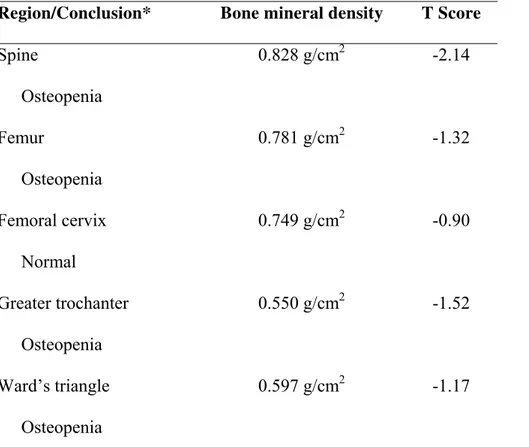Case report
Impact of antipsychotic agents in bone mineral density of schizophrenic patients
Lísia Rejane Guimarães* Carmen Lúcia Leitão-Azevedo* Martha Guerra Belmonte de Abreu**
Clarissa Severino Gama*** Maria Inês Lobato*** Paulo Belmonte-de-Abreu****
This study was carried out at the Schizophrenia Program at Hospital de Clínicas de Porto Alegre (HCPA), Porto Alegre, RS, Brazil.
* Dietitian. Specialist in Clinical Nutrition. MSc. student, Graduate Program in Psychiatry, Universidade Federal do Rio Grande do Sul (UFRGS), Porto Alegre, RS, Brazil.
** Dietitian. Specialist in Public Health. MSc. in Medicine: Psychiatry, UFRGS, Porto Alegre, RS, Brazil.
*** Psychiatrist, Schizophrenia Program, HCPA, Porto Alegre, RS, Brazil. PhD in Medicine: Medical Clinic, UFRGS, Porto Alegre, RS, Brazil.
**** Psychiatrist, Schizophrenia Program, HCPA, Porto Alegre, RS, Brazil. PhD in Medicine: Medical Clinic, UFRGS, Porto Alegre, RS, Brazil. Member, Committee of Experts in Psychoactive Drugs, Coordination of Full Attention Policy to Mental Health, Rio Grande do Sul State
Department of Health.
INTRODUCTION
The use of antipsychotics has been pointed as factor for osteopenia/osteoporosis or reduced bone mineral density (BMD) in schizophrenic patients, due to increased prolactin blood levels caused by drugs.1-6 The treatment using antipsychotics results in the blockade of D2 dopamine receptors and subsequent hyperprolactinemia.3 Increased prolactin blood levels suppress the reproductive endocrine system, due to the reduction in synthesis of sexual hormones.
Hyperprolactinemia is associated with the suppression of secretion of gonadotropin-releasing hormone (GnRH) and luteinizing hormone (LH) of the hypothalamus, compromising the pituitary response to GnRH.3 High prolactin levels have inhibitory effects on the release of GnRH
hypothalamic impulses and lead to the inhibition of positive feedback effects in estradiol levels over LH secretion. The primary mechanism of bone loss is a result of the hypogonadism that occurs in a subset in men and women with hyperprolactinemia.7 Although the mechanisms and most visible effects of hyperprolactinemia are known, such as secondary amenorrhea and reduced libido, little attention has been drawn to these patients in relation to the identification of the impact of
antipsychotics on another important parameter of health, which is the BMD of that population.3,8
CASE REPORT
patient presented hypothyroidism due to lithium and, after suspension, she became euthyroid. Bone densitometry was requested after hyperprolactinemia caused by antipsychotics and consequent deleterious effect on the bone due to hypogonadism. The results showed osteopenia of the spine and total proximal femur, according to criteria defined by the World Health Organization (table 1).
Table 1 - Bone mineral density of this case report
Region/Conclusion* Bone mineral density T Score
Spine 0.828 g/cm2 -2.14
Osteopenia
Femur 0.781 g/cm2 -1.32
Osteopenia
Femoral cervix 0.749 g/cm2 -0.90
Normal
Greater trochanter 0.550 g/cm2 -1.52
Osteopenia
Ward’s triangle 0.597 g/cm2 -1.17
Osteopenia
* Criteria established by the World Health Organization (1994) for lumbar spine, femoral cervix and middle third of the radius: BMD up to -1 (T score): normal; BMD between -1 and -2.5 (T score): osteopenia; BMD ≤ -2.5 (T score): osteoporosis; and BMD ≤ -2.5 (T score) associated with fragility fracture: established osteoporosis.
DISCUSSION
The literature warns about the need of drawing more attention to psychiatric patients, since antipsychotics seem to induce hyperprolactinemia, increasing the potential to develop
typical antipsychotics,4,6 and there is evidence of the increase in mean prolactin levels of
approximately three times above the normal limit in both genders. However, other studies suggest that atypical may be safer than typical neuroleptics in terms of BMD reduction2 and seem to reduce the effect caused by the prolactin hormone.6 Antipsychotics are not recognized by the World Health Organization, neither by the Royal College of Physicians as risk factor for osteoporosis, and there are still no epidemiological studies to investigate the prevalence of BMD reduction in schizophrenic patients. Therefore, further studies are recommended.3
REFERENCES
1. Naidoo U, Goff DC, Klibanski A. Hyperprolactinemia and bone mineral density: the potential impact of antipsychotic agents. Psychoneuroendocrinology. 2003;28 Syuppl 2:97-108.
2. Bilici M, Cakirbay H, Guler M, Tosun M, Ulgen M, Tan U. Classical and atypical neuroleptics, and bone mineral density, in patients with schizophrenia. Int J Neurosci. 2002;112(7):817-28.
3. Meaney AM, O’Keane V. Reduced bone mineral density in patients with schizophrenia receiving prolactin raising anti-psychotic medication. J Psychopharmacol. 2003;17(4):455-8. 4. Meaney AM, Smith S, Howes OD, O’Brien M, Murray RM, O’Keane V. Effects of
long-term prolactin-raising antipsychotic medication on bone mineral density in patients with schizophrenia. Br J Psychiatry. 2004;184:503-8.
5. Lean M, De Smedt G. Schizophrenia and osteoporosis. Int Clin Psychopharmacol. 2004;19(1):31-5.
6. Kinon BJ, Gilmore JA, Liu H, Halbreich UM. Prevalence of hyperprolactinemia in
schizophrenic patients treated with conventional antipsychotic medications or risperidone. Psyschoneuroendocrinology. 2003;28 Suppl 2:55-68.
7. Misra M, Papakostas GI, Klibanski A. Effetcs of psychiatric disorders and psychotropic medications on prolactin and bone metabolism. J Clin Psychiatry. 2004;65(12):1607-18. 8. Abraham G, Friedman RH, Verghese C. Osteoporosis demonstrated by dual energy x-ray
absorptiometry in chronic schizophrenic patients. Biol Psychiatry. 1996;40(5):430-1. 9. Costa AF, Picon PD, Amaral KM. Protocolo clínico e diretrizes terapêuticas: osteoporose.
In: Brasil, Ministério da Saúde, Secretaria de Assistência à Saúde, Departamento de
ABSTRACT
Studies have shown a high risk of osteoporosis in schizophrenic patients. Some studies have
demonstrated that typical neuroleptics and risperidone may induce osteoporosis or reduce bone
mineral density. This can be due to the fact that prolonged use of those drugs induces
hyperprolactinemia to levels above normal in both genders, and reduces the levels of estrogen and
testosterone, thus increasing the risk of osteopenia/osteoporosis. We report on a case of osteopenia
in a 53-year-old female patient using antipsychotics for 30 years. We comment on the recommended
procedures to detect osteopenia and on the existing guidelines for its management.
Keywords: Case report, schizophrenia, bone mineral density, antipsychotics.
Title: Impact of antipsychotic agents in bone mineral density of schizophrenic patients
Correspondence:
Lísia Rejane Guimarães
Trav. Antilhas, 56, Jardim Lindóia
